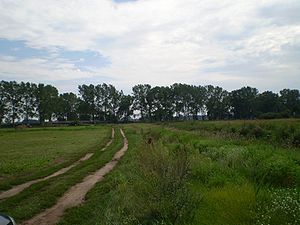
Puszcza Zielona
Encyclopedia

Poland
Poland , officially the Republic of Poland , is a country in Central Europe bordered by Germany to the west; the Czech Republic and Slovakia to the south; Ukraine, Belarus and Lithuania to the east; and the Baltic Sea and Kaliningrad Oblast, a Russian exclave, to the north...
which extends from the Narew River and the border of what was once East Prussia
East Prussia
East Prussia is the main part of the region of Prussia along the southeastern Baltic Coast from the 13th century to the end of World War II in May 1945. From 1772–1829 and 1878–1945, the Province of East Prussia was part of the German state of Prussia. The capital city was Königsberg.East Prussia...
. It is bounded on the east by the Pisa River
Pisa River
The Pisa is a river in north-eastern Poland with a length of 80.4 km. It belongs to the Masurian Lake District of the Warmian-Masurian Voivodeship. The Pisa river flows from Lake Roś near the town of Pisz, and is a tributary of the Narew, connecting the Lakeland region with the Vistula...
and on the west by the Orzyc River. The forest lies in a lowland and contains a wet sandy soil, but it is rich in various minerals which are mined.
The Green Wilderness (Puszcza Zielona) is usually associated with the White Wilderness (Puszcza Biała), and together the two forests are often referred to as the Kurpie Forest (Puszcza Kurpiowska
Puszcza Kurpiowska
Puszcza Kurpiowska or Kurpiowska Forest, is the collective name of Poland's two wilderness areas: Puszcza Biała and Puszcza Zielona , located in the central basin of Narew and Kurpiowska Plain. It is bound by the rivers: Pisa , Narew and Orzyc . The north-end reaches the former border with East...
) because the two forests were populated by inhabitants who, over the centuries of isolation, developed a unique culture of their own, called Kurpie
Kurpie
Kurpie is one of a number of ethnic regions in Poland, noted for its unique traditional customs, such as its own types of traditional costume, traditional dance, and distinctive type of architecture and livelihoods...
.
History
The forest was first ordered colonized by Masovian Prince Janusz I in the first half of the 14th Century by peasants and petty noblesSzlachta
The szlachta was a legally privileged noble class with origins in the Kingdom of Poland. It gained considerable institutional privileges during the 1333-1370 reign of Casimir the Great. In 1413, following a series of tentative personal unions between the Grand Duchy of Lithuania and the Kingdom of...
. Colonization continued on and off subsequently, and its inhabitants, because of their isolation by living deep in a forest, developed a distinct culture. They were given the derogatory name of kurpś, because of their crude shoes which were made of fibers from the linden tree and sealed with lime
Lime (mineral)
Lime is a general term for calcium-containing inorganic materials, in which carbonates, oxides and hydroxides predominate. Strictly speaking, lime is calcium oxide or calcium hydroxide. It is also the name for a single mineral of the CaO composition, occurring very rarely...
. Eventually, these people formed a unique culture known as Kurpie
Kurpie
Kurpie is one of a number of ethnic regions in Poland, noted for its unique traditional customs, such as its own types of traditional costume, traditional dance, and distinctive type of architecture and livelihoods...
.
Current status
Because of forest clearing for agricultural purposes over the centuries, much of the forest remains in broken patches. Villages which once housed Kurpie-style structures have now been replaced, for the most part, by more modern structures.Portions of the forest are being preserved and protected as nature preserves by the Polish government.
Nature preserves pertaining to Puszcza Zielona
- Rezerwat Czarnia
- Rezerwat Kaniston
- Rezerwat przyrody Ciemny Kąt
- Rezerwat przyrody Łokieć

